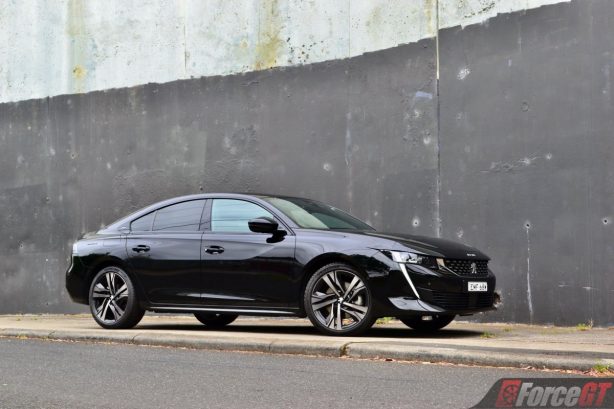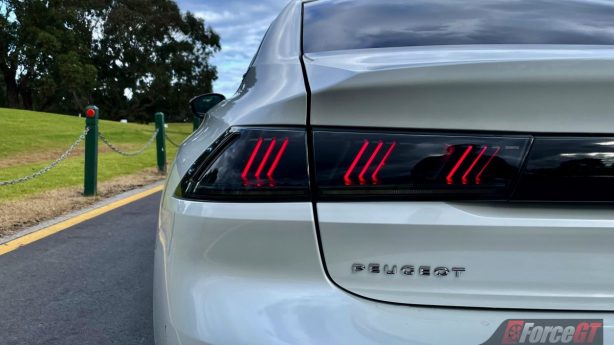What is it?
The Peugeot 508 is a midsize car offered in liftback and wagon body styles. Launched in 2019, the current generation model introduced a new design language and brought a change in market direction for the French marque. The bold styling is matched with an upmarket interior to reposition the 508 as a semi-premium offering, that is not quite BMW 3 Series but higher status than a Toyota Camry. Think of its rivals as the upper-spec models of the Mazda 6 and Volkswagen Passat and you’d get the idea.
It’s reflected in the hefty pricing. The 508 Fastback and Sportswagon petrol variants are respectively priced from $53,990 and $55,990, while the 508 Fastback Plug-in Hybrid EV (PHEV) comes in at a steep $76,990. All prices exclude on-road costs.
Premium exterior colour choice and an opening panoramic sunroof are the only options.
Does it look the part?
Completely redesigned from the ground up, the latest 508 styling is one of Peugeot’s best work. The low-slung silhouette is characterised by sleek lines and contoured surfaces, with contemporary and appropriately French detailing around the front fascia and taillights. The grille is wide and purposeful, flanked by LED projector headlights with daytime running lights that extend down to the bumper. At the rear, the fastback design is defined by that sweeping roof line that tapers down to the rear deck. The smoked taillights feature illuminated motives that light up day and night.
It’s a beautiful design that exudes class and sophistication, one that stands out from the crowd. Peugeot says the sedan segment is ripe for a shake-up. With the way the 508 looks it’s set to do just that.
What about the interior?
Peugeot has been churning out some of the most impressive interiors lately and the 508 continues that trend. The interior design is contemporary styling at its best, mixed in with a premium vide that radiates throughout the cabin. The materials used are top shelve stuff and the interior mood lighting is a nice touch.
The layered dashboard is both functional and ergonomically laid out, with controls and a 10-inch touchscreen wide display within easy reach of the driver and front passenger.
Being French, a little quirkiness is not unexpected and it’s most evident in the Peugeot i-Cockpit. It combines a compact two-spoke steering wheel with a 12.3-inch fully digital instrument cluster which sits high up in the dash. Peugeot calls the digital instrumentation the head-up digital display and it’s meant to be viewed from above the steering wheel, not through it.
We have driven many Peugeot models with i-Cockpit and we don’t mind it, but for those who are new to this unusual layout they might need sometime to get used to it.
The digital display is fully customisable, from the colour of the animated gauges to the option of having the navigation map displayed. The odd inverted tachometer aside, it’s a very cool display.
The centre touchscreen operates not just the media and navigation but also the climate control. While the screen is responsive to the touch and the menu structure isn’t too bad, we’re not a fan of the embedded climate control as you need to take your eyes off the road to operate it.
Peugeot still hasn’t gotten their 360-degree surround view camera right, as the important safety and parking feature fails to properly render the vision almost every time, with blacked out patches at the front and rear of the vehicle preventing it from displaying a full birds’ eye view of the car.
Is it practical?
The standard Nappa leather seats offer great comfort and support up front. With eight-way electric adjustment, including lumbar support, finding the ideal seating position is easy. The back seats aren’t as cocooning though, as they are firmer and flatter. Leg and knee room is fine but headroom is tight for those long in the legs, as is toe room.
The front door pockets are easy to access and can comfortably accomodate a water bottle each, but the rear pockets are tight.
The front armrest conveniently splits and opens in the middle to reveal a decent central storage. More covered storage for the odds and bobs can be found next to the gear lever.
The pair of cup holders in the centre console and another pair behind the drop down rear armrest are on the small side but they will still fit the average Australian coffee cups, just that it’s a snug fit and you can’t just casually ‘drop’ the cup in.
The boot measures 487 litres, which is relatively spacious for a medium car with more stylish than practical intent. The liftback architecture means the boot aperture is large, this combines with powered tailgate operation to make loading a breeze. Stowe away the 40:60 split rear seats and the space expands to 1,537 litres.
What’s under the bonnet?
The Peugeot 508 is now available with two powertrain options. The petrol version is powered by a turbocharged 1.6-litre four-cylinder engine developing 165kW and 300Nm. It’s mated to an eight-speed automatic transmission which sends drive to the front wheels. Peugeot claims a 0-100km/h time of 8.1 seconds for the petrol-powered 508.
The plug-in hybrid variant also uses a turbo 1.6-litre petrol, albeit tuned differently to produce 133kW and 300Nm. It’s backed by an electric motor rated at 81kW and 320Nm. The combined output of 165kW/360Nm is channel to the front wheels via an eight-speed auto that is calibrated to suit the hybrid powertrain.
The hybrid model is capable of an electric-only range of up to 55km, and its 0-100km/h time is slightly slower than the petrol’s at 8.3 seconds.
How does it drive?
We drove both the petrol and hybrid powertrains in liftback (sedan) form. The petrol variant, without the heavy drive battery pack, is inherently lighter at a kerb weight of 1420kg. It’s not just lighter than the hybrid model but also many of its non-hybrid rivals, which all tip over 1500kg. And this translates to one of the best driving performance in the segment.
The 508 petrol is eager to get up to speed from standstill, with a relatively strong and linear power delivery from around 2000rpm through to 5000rpm. Engine refinement is good, too, with a muted operation on cruise and a pleasant growl when prodded.
The Aisin-sourced automatic transmission works discretely in the background, with smooth gear changes in auto mode and good response to the paddle shifters when operated.
The tuning of the drivetrain feels just right – it’s neither too highly strung nor too lazy.
And the suspension tuning follows the same principle. It’s well balanced. There’s a layer of firmness to the ride for stability, yet bumps and ruts are soaked up with aplomb. Toss it into a corner and it doesn’t disappoint either. The steering response is sharp and body roll is well suppressed. Make no mistake, this isn’t a sports sedan, so this isn’t the car you take out for a spirited drive. It’s more of a grand tourer with competent handling.
The hybrid model is quite a lot heavier than the petrol version. With a kerb weight of 1720kg, performance is duller than the petrol version, despite having 60Nm more torque. The dynamics aren’t as sharp either as there’s quite a lot of weight to carry through corners.
That said, on face value the 508 hybrid is still a well balanced car. It’s a relaxing cruiser for the day to day commute, which, with its 55km electric range on a full charge, will be mostly emission free for most people. We find Peugeot’s EV range a little optimistic though, as the most we could ever get out of a full charge was around 48km, and that’s with a fairly light right foot, air-con switched on about 70 percent of the time and a mixture of urban and highway driving.
Just like any EV, the drive in full electric mode is smooth and quiet. In normal operation the battery charge is depleted in EV drive mode before entering hybrid mode, where the engine kicks in, working in parallel with the electric motor to extend the range. Hybrid mode can still be manually activated by the driver at anytime to preserve battery charge. This is useful when driving on the highway for example, where fuel use is low and engine power is preferred. The preserved battery charge is saved for urban driving later, where fuel use is high and EV is preferred.
The transition from EV to hybrid is almost seamless, though under engine power you’ll feel the transmission stepping through its ratios, faintly. The regenerative braking is fine given how similar in feel the brake pedal is to that of its non-hybrid counterpart.
Both 508 models are comprehensively equipped with advanced safety assist systems including adaptive cruise control, forward collision warning, auto emergency braking, blind spot monitoring, lane keep assist and auto high beam. However, rear cross traffic alert is lacking.
What’s the cost to own one?
Like most brands these days, Peugeot offers a five-year, unlimited-kilometre warranty, along with five-year roadside assist. Capped-price servicing is available. The average cost per service (over 5 years) for the 508 petrol is $678.80, while the 508 PHEV is cheaper at $527.80. Over 5 years, the total cost of servicing for the 508 petrol and 508 PHEV is respectively $3,394.00 and $2,639.00.
Both 508 variants require a service every 20,000km or 12 months, whichever comes first.
In terms of fuel use, the 508 petrol recorded a real world tested combined average of 8.1L/100km, against a rated 6.3L/100km. The hybrid uses no fuel when driven in EV mode, while in hybrid mode it’s still the more economical car with a tested average of 6.1L/100km. On paper, the hybrid is rated at just 1.8L/100km.
Verdict
Design & Comfort
Performance & Handling
Quality
Economy
Equipment & Features
OUR SCORE
4.1/5
+ Plus
- Classy good looks
- Premium interior
- Balanced performance
– Minus
- Pricey
- Some electronic gremlins
- Embedded climate controls
Overall
The Peugeot 508 is nice to look at, even nicer to sit in and a pleasure to drive. It has the semi premium brief nailed. However, there’s a high price to pay for all these niceties. The PHEV variant especially is too expensive. If you don’t mind those and want to stand out from the crowd, the 508 is certainly worth giving a thought.
2023 Peugeot 508 GT Fastback Pricing and Specification
| Price (Excl. on-road costs): | 508 GT Petrol Fastback: $53,990 508 GT PHEV Fastback: $76,990 |
| Warranty: | 5 years/Unlimited kilometres |
| Country of Origin: | France |
| Service Intervals: | 12 months / 20,000km |
| Engine: | Petrol: 1.6-litre turbocharged four-cylinder petrol 165kW @ 5500rpm, 300Nm @ 2750rpm PHEV: 1.6-litre turbocharged four-cylinder petrol, electric motor Engine: 133kW @ 6000rpm, 300Nm @ 3000rpm Electric motor: 81kW, 320Nm Total: 165kW, 360Nm |
| Transmission: | 8-speed automatic |
| Drivetrain: | Front-wheel drive |
| Combined Fuel Consumption (L/100km): | Petrol: Claimed: 6.3/ Tested: 8.1 PHEV: Claimed: 1.8/ Tested: 6.1 |
| RON Rating: | 95 |
| Fuel Capacity (L): | Petrol: 62 PHEV: 43 |
| Body: | 4-door sedan, 5 seats |
| Safety: | 5-star ANCAP, 6 Airbags, ABS, ESC, TCS, EBD, BA, Reversing Camera, 360-degree Surround View Monitor, Blind Spot Detection, Lane Departure Warning, Tyre Pressure Monitoring System, Adaptive Cruise Control |
| Dimensions (L/W/H/W-B) mm: | 4,750/1,860/1,410/2,800 |
| Kerb Weight (kg): | Petrol: 1,420 PHEV: 1,720 |
| Towing Capacity (kg): | Petrol: Braked: 1600kg / Unbraked: 750kg PHEV: Braked: 1330kg / Unbraked: 745kg |
| Entertainment: | 10.0-inch colour touchscreen with Satellite Navigation, DAB, Bluetooth, Apple CarPlay, Android Auto, USB, Focal 10-speaker premium audio with subwoofer and amplifier |
 ForceGT.com Car News, Car Reviews, Video Reviews, Tuning and much more.
ForceGT.com Car News, Car Reviews, Video Reviews, Tuning and much more. 























































